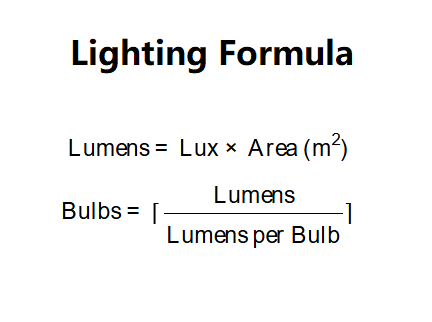1. What is a Lighting Calculator?
Definition: This calculator determines the number of light bulbs needed to achieve a desired illuminance level in a room, based on the room's dimensions, the required lux level, and the lumens per bulb.
Purpose: It helps users plan the lighting for various spaces (e.g., kitchen, bedroom, bathroom) to ensure adequate illumination for different activities.
2. How Does the Calculator Work?
The calculator uses the following formulas:
Area:
\[
\text{Area} = \text{Length} \times \text{Width}
\]
Required Lumens:
\[
\text{Required Lumens} = \text{Area} \times \text{Illuminance (lux)}
\]
Number of Bulbs Needed:
\[
\text{Number of Bulbs} = \left\lceil \frac{\text{Required Lumens}}{\text{Lumens per Bulb}} \right\rceil
\]
Where:
- Area: The area of the room (m² or ft²)
- Length: Length of the room
- Width: Width of the room
- Illuminance: Desired light intensity in lux (lx)
- Required Lumens: Total lumens needed to achieve the desired illuminance
- Lumens per Bulb: Light output of one bulb in lumens (lm)
- Number of Bulbs: Total bulbs needed (rounded up)
Unit Conversions:
- Centimeters to Meters: 1 cm = 0.01 m
- Meters to Meters: 1 m = 1 m
- Inches to Meters: 1 in = 0.0254 m
- Feet to Meters: 1 ft = 0.3048 m
- Square Meters to Square Feet: 1 m² = \( \frac{1}{0.092903} \) ft²
Steps:
- Select the illuminance type (e.g., Kitchen - 300 lux).
- Enter the room's length and width, selecting the unit (cm, m, in, ft).
- Enter the lumens per bulb for your chosen light bulb type.
- Convert length and width to meters.
- Calculate the area using \( \text{Area} = \text{Length} \times \text{Width} \).
- Calculate the required lumens using \( \text{Required Lumens} = \text{Area} \times \text{Illuminance} \).
- Calculate the number of bulbs needed by dividing the required lumens by the lumens per bulb and rounding up.
- Display the area (in selected unit), required lumens, and number of bulbs needed.
3. Importance of Lighting Calculation
Calculating the correct lighting is crucial for:
- Comfort: Ensures the room is adequately lit for its intended use (e.g., bright for tasks, softer for relaxation).
- Energy Efficiency: Prevents over-illumination, saving electricity.
- Safety: Provides sufficient light for tasks like cooking or shaving, reducing the risk of accidents.
4. Using the Calculator
Examples:
- Example 1: Illuminance = Kitchen - 300 lux, Length = 4 m, Width = 3 m, Lumens per Bulb = 800 lm:
- Area: \( 4 \times 3 = 12 \, \text{m}^2 \)
- Required Lumens: \( 12 \times 300 = 3600 \, \text{lm} \)
- Number of Bulbs: \( \left\lceil \frac{3600}{800} \right\rceil = \left\lceil 4.5 \right\rceil = 5 \)
- Example 2: Illuminance = Bedroom (lower) - 100 lux, Length = 10 ft, Width = 8 ft, Lumens per Bulb = 400 lm:
- Length in m: \( 10 \times 0.3048 = 3.048 \, \text{m} \)
- Width in m: \( 8 \times 0.3048 = 2.4384 \, \text{m} \)
- Area: \( 3.048 \times 2.4384 \approx 7.43 \, \text{m}^2 \)
- Area in ft²: \( 7.43 \div 0.092903 \approx 79.97 \, \text{ft}^2 \)
- Required Lumens: \( 7.43 \times 100 \approx 743 \, \text{lm} \)
- Number of Bulbs: \( \left\lceil \frac{743}{400} \right\rceil = \left\lceil 1.8575 \right\rceil = 2 \)
5. Frequently Asked Questions (FAQ)
Q: What is the difference between lux and lumens?
A: Lux measures the light intensity over an area (lumens per square meter), while lumens measure the total light output from a bulb.
Q: Why do different rooms need different illuminance levels?
A: Different activities require different light levels. For example, a kitchen needs brighter light for cooking (300 lux), while a bedroom may need softer light for relaxation (100 lux).
Q: Why is the number of bulbs rounded up?
A: Rounding up ensures that the room has at least the required illuminance, as you cannot use a fraction of a bulb.
 Home
Home
 Back
Back
